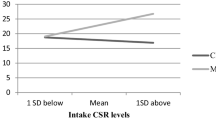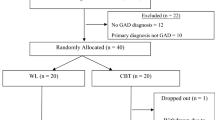Abstract
The development of treatments based on cognitive models of worry has led to improved outcomes for adults with Generalized Anxiety Disorder (GAD), and holds out the promise that similar improvements may be achieved for GAD further down the age range. The aim of the current study was to evaluate the effect of a GAD-specific, cognitive treatment in a sample of children and adolescents with GAD. Sixteen youth (7–17 years of age) who were consecutive referrals to a specialty anxiety disorders clinic, with a primary diagnosis of DSM-IV GAD, and who were not undergoing concurrent pharmacological treatment for anxiety were provided 5 to 15 session (mean = 9.7) of cognitive therapy aimed at their tolerance for uncertainty, beliefs about worry, negative problem orientation, and cognitive avoidance strategies. All participants who entered the study completed treatment and 13 (81%) lost their GAD diagnosis (not blindly assessed); two were improved but still had GAD and one experienced no improvement at all. Age, gender and number of sessions received were unrelated to diagnostic outcome but age was positively correlated (r = 0.6, P < .01) with pre-to-post reductions in worry frequency. The uncontrolled effect size for self-reported worry was 2.0 and for anxiety was 1.4. Further controlled evaluations of this cognitive treatment for GAD in children and adolescents are warranted.
Similar content being viewed by others
References
American Psychiatric Association. (1994). Diagnostic and statistical manual of mental disorders (4th ed.). Washington, DC: APA.
Barlow, D. H., Cohen, A. S., Waddell, M. T., Vermilyea, B. B., Klosko, J. S., Blanchard, E. B., et al. (1984). Panic and generalized anxiety disorders: Nature and treatment. Behavior Therapy, 15, 431–449.
Chorpita, B. F., Tracey, S. A., Brown, T. A., Colica, T. J., & Barlow, D. H. (1997). Assessment of worry in children and adolescents: An adaptation of the Penn State worry questionnaire. Behaviour Research and Therapy, 35, 569–581.
Dugas, M. J., Brillon, P., Savard, P., Turcotte, J., Gaudet, A., Ladouceur, R., et al. (2010). A randomized clinical trial of cognitive-behavioural therapy and applied relaxation for adults with generalized anxiety disorder. Behavior Therapy, 41(1), 46–58.
Dugas, M. J., Gagnon, F., Ladouceur, R., & Freeston, M. H. (1998). Generalized anxiety disorder: A preliminary test of a conceptual model. Behavior Research & Therapy, 36, 215–226.
Dugas, M., & Robichaud, M. (2007). Cognitive-behavioural therapy for generalized anxiety disorder. Routledge: New York.
Eisen, A. R., & Silverman, W. K. (1993). Should I relax or change my thoughts? A preliminary examination of cognitive therapy, relaxation training, and their combination with overanxious children. Journal of Cognitive Psychotherapy: An International Quarterly, 7, 265–279.
Eisen, A. R., & Silverman, W. K. (1999). Prescriptive treatment for generalized anxiety disorder in children. Behavior Therapy, 29(1), 105–121.
Hunt, C., Issakidis, C., & Andrews, G. (2002). DSM-IV generalized anxiety disorder in the Australian national survey of mental health and well-being. Psychological Medicine, 32, 649–659.
Jacobson, N., & Truax, P. (1991). Clinical significance: A statistical approach to defining meaningful change in psychotherapy research. Journal of Consulting and Clinical Psychology, 59(1), 12–19.
Kane, M. T., & Kendall, P. C. (1989). Anxiety disorders in children: A multiple-baseline evaluation of a cognitive-behavioral treatment. Behavior Therapy, 20, 499–508.
Kendall, P. C. (1990). The coping cat manual. Ardmore, PA: Workbook Publishing.
Kendall, P. C., Compton, S. N., Walkup, J. T., Birmaher, B., Albano, A. A., Sherrill, J., Ginsburg, G., Rynn, M., McCracken, J., Gosch, E., Keeton, C., Bergman, L., Sakolsky, D., Suveg, C., Iyengar, S., March, J., & Piacentini, J. (2010). Clinical characteristics of anxiety disordered youth. Journal of Anxiety Disorders, 24(3), 360-365.
Kessler, R. C., Berglund, P., Demler, O., Jin, R., Merikangas, K. R., & Walters, E. E. (2005). Lifetime prevalence and age-of-onset distributions of DSM-IV disorders in the national comorbidity survey replication. Archives of General Psychiatry, 62, 593–602.
Last, C. G., Hansen, C., & Franco, N. (1997). Anxious children in adulthood: A prospective study of adjustment. Journal of the American Academy of Child & Adolescent Psychiatry, 36, 645–652.
Last, C. G., Perrin, S., Hersen, M., & Kazdin, A. E. (1992). DSM-III-R anxiety disorders in kids: Sociodemographic and clinical characteristics. Journal of the American Academy of Child & Adolescent Psychiatry, 31, 1070–1076.
Last, C. G., Perrin, S., Hersen, M., & Kazdin, A. E. (1996). A prospective study of anxiety disorders in children. Journal of the American Academy of Child & Adolescent Psychiatry, 35, 1502–1510.
Leger, E., Ladouceur, R., Dugas, M. J., & Freeston, M. H. (2003). Cognitive-behavioural treatment of generalized anxiety disorder among adolescents: A case series. Journal of the American Academy of Child & Adolescent Psychiatry, 42, 327–330.
Maier, W., Gaensicke, M., Freyberger, H. J., Linz, M., Heun, R., & Lecrubier, Y. (2000). Generalized anxiety disorder (ICD-10) in primary care from a cross-cultural perspective: A valid diagnostic entity? Acta Psychiatrica Scandinavica, 101, 29–36.
March, J. S., Parker, J. D., Sullivan, K., Stallings, P., & Conners, C. (1997). The multidimensional anxiety scale for children: Factor structure, reliability, and validity. Journal of the American Academy of Child & Adolescent Psychiatry, 36, 554–565.
March, J. S., Sullivan, K., & Parker, J. (1999). Test-retest reliability of the multidimensional anxiety scale for children. Journal of Anxiety Disorders, 13(4), 349–358.
Meltzer, H., Gatward, R., Goodman, R., & Ford, T. (1999). The mental health of children and adolescents in Great Britain. London, England: Office for National Statistics.
Muris, P., Meesters, C., & Gobel, M. (2001). Reliability, validity, and normative data of the Penn State Worry Questionnaire in 8–12-year-old children. Journal of Behavior Therapy & Experimental Psychiatry, 32(2), 63–72.
Scheibe, G., & Albus, M. (1992). Age at onset, precipitating events, sex distribution, and co-occurrence of anxiety disorders. Psychopathology, 25, 11–18.
Schneider, S., & In-Albon, T. (2006). Die psychotherapeutische Behandlung von Angststörungen im Kindes- und Jugendalter—was ist evidenzbasiert? Zeitschrift fur Kinder—und Jugendpsychiatry und Psychotherapie, 34(3), 191–201. [Psychotherapy for anxiety disorders in childhood and adolescence—what is evidence-based?].
Silverman, W., & Nelles, W. (1998). The anxiety disorders interview schedule for children. Journal of the American Academy of Child and Adolescent Psychiatry, 27, 772–778.
Silverman, W. K., Pina, A. A., & Viswesvaran, C. (2008). Evidence-based psychosocial treatments for phobic and anxiety disorders in children and adolescents. Journal of Clinical Child & Adolescent Psychology, 37(1), 105–130.
SPSS. (2008). SPSS for Windows, Release 17. Chicago: SPSS Inc.
Wittchen, H. U., & Hoyer, J. (2001). Generalized anxiety disorder: Nature and course. Journal of Clinical Psychiatry, 62(suppl 11), 9–59. (Discussion 20–1).
Yonkers, K. A., Warshaw, M. G., Massion, A. O., & Keller, M. B. (1996). Phenomenology and course of generalised anxiety disorder. British Journal of Psychiatry, 168, 308–313.
Acknowledgments
The authors gratefully acknowledge the help generously given by the children, adolescents and parents taking part in this project. Dr Payne was fully supported and Professor Bolton and Dr Perrin partly supported by the National Institute for Health Research’s Biomedical Research Centre for Mental Health at the South London and Maudsley NHS Foundation Trust and Kings College London/Institute of Psychiatry.
Conflict of interest
No conflicts declared.
Author information
Authors and Affiliations
Corresponding author
Additional information
Statement that informed consent has been appropriately obtained.
Rights and permissions
About this article
Cite this article
Payne, S., Bolton, D. & Perrin, S. A Pilot Investigation of Cognitive Therapy for Generalized Anxiety Disorder in Children Aged 7–17 Years. Cogn Ther Res 35, 171–178 (2011). https://doi.org/10.1007/s10608-010-9341-z
Published:
Issue Date:
DOI: https://doi.org/10.1007/s10608-010-9341-z




